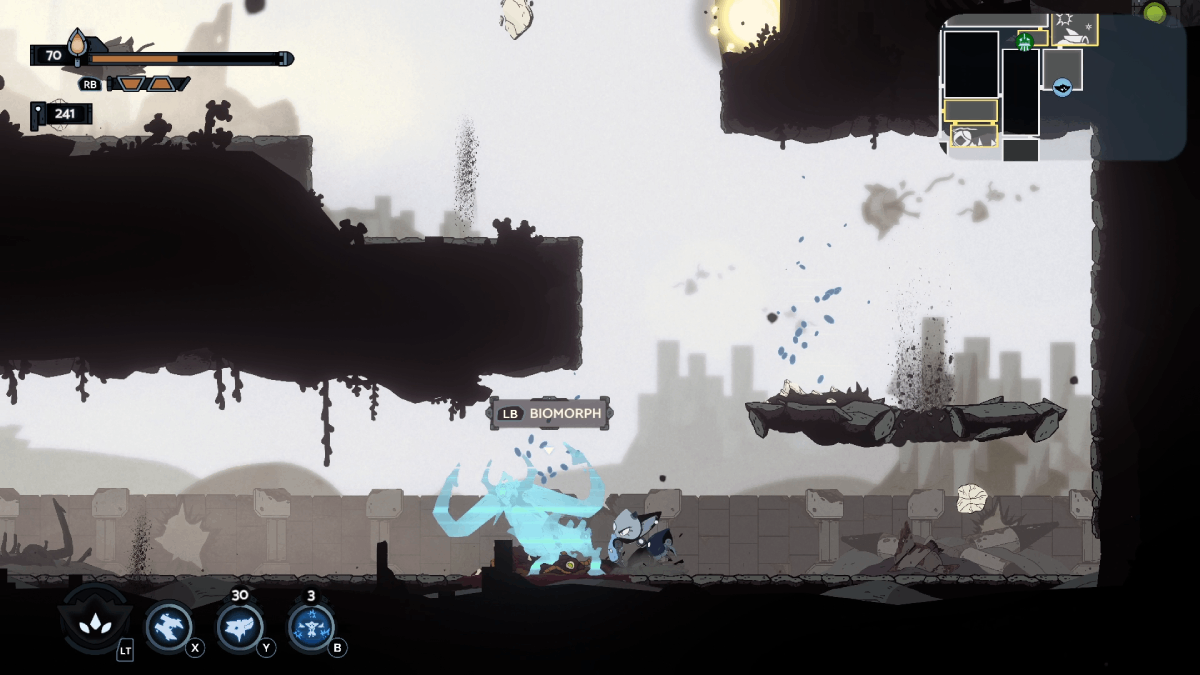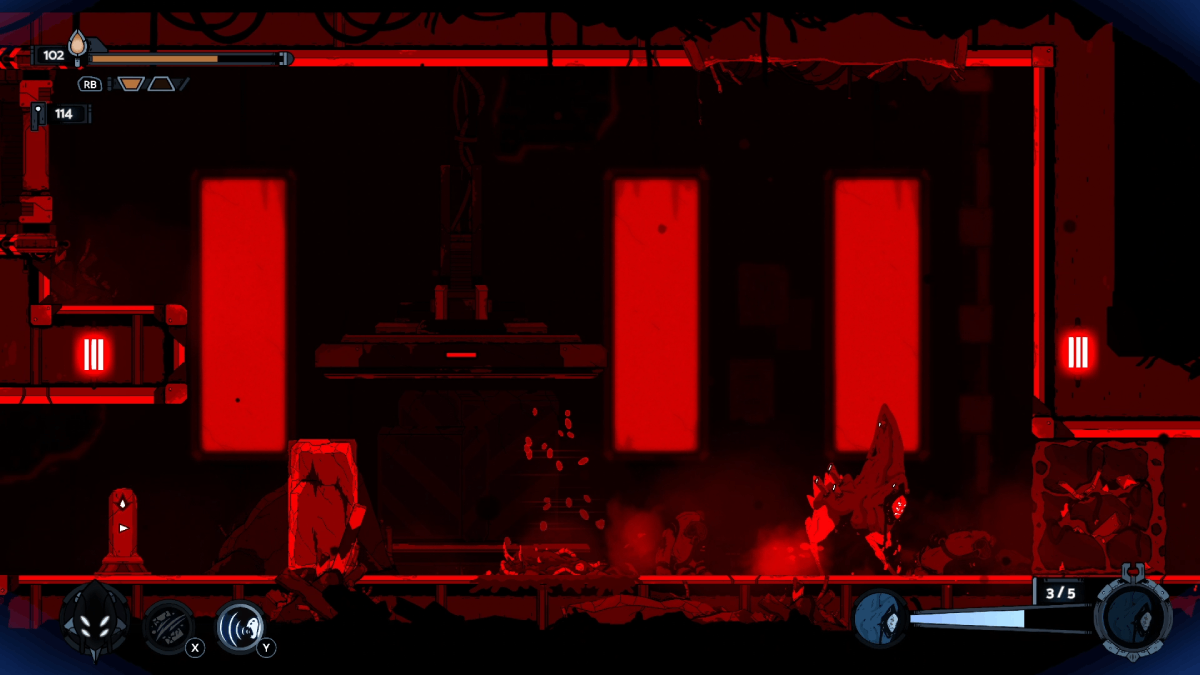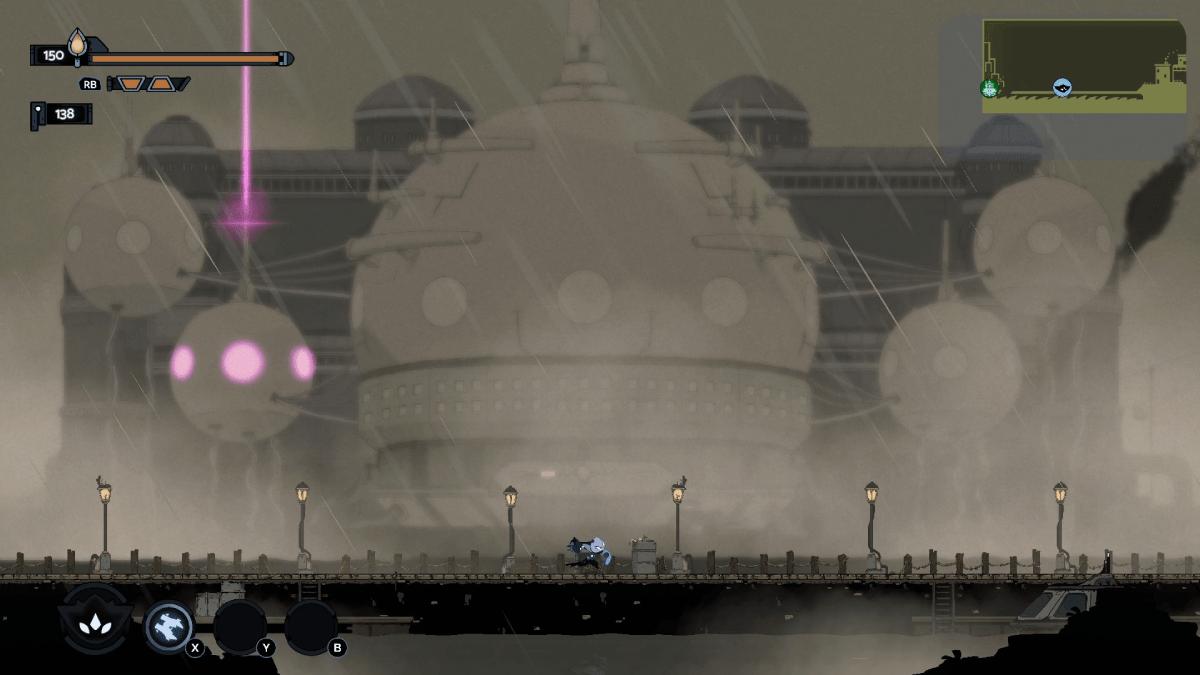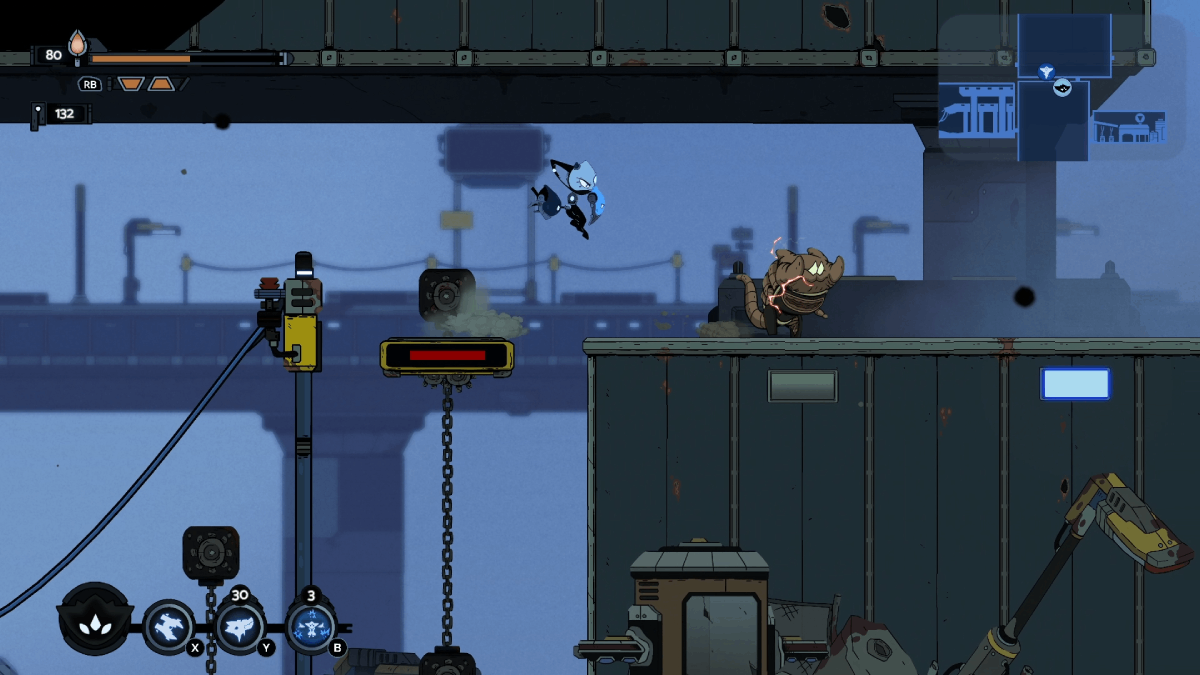There are a lot of indie Metroidvanias out there, to the point where it can be hard for any of them to stand out. To solve this problem, Biomorph comes with a unique gimmick: you can transform into most of the creatures you defeat, using their unique abilities to progress.
It’s an interesting concept, and it gets put to work relatively quickly. After defeating a grim calcified elk creature, our protagonist absorbs its essence in an animated cutscene. Immediately after, he finds that he can use the creature’s solid hide to charge through some debris and open an exit. You’ll use a few of these, as well as a brutish amalgamation whose punch has similar effects, to escape the opening prologue.
How can the protagonist do this? Honestly, he’s not sure. Hi name is Harlo, a cat-like alien who looks like a moody Ratchet with bionic Rayman hands. He wakes up in a strange facility and remembers nothing about how he got there or where he came from. He realizes that a friend is trapped in a cell, attempts a rescue, and ends up exploding out into a wider world. As the game progresses, Harlo seeks to save his friend, recover his memories and help rebuild a derelict village in the process.

The structure of Biomorph is exactly what you’d expect from any given Metroidvania. Following the prologue, you find yourself in the village of Blightmoor, a run-down port town. From here, Harlo can explore a large world, find new abilities, and then travel down new paths with those abilities. If you’ve played any game in the genre, you know how this works.
Biomorph starts strong. Using creature abilities to smash open routes in the opening prologue is a great mechanic, which only opens more possibilities once you’re in the main world. One creature fires a projectile which can be used to activate faraway switches. Another can casually walk on spikes, allowing you access to areas that would otherwise harm you. Later on, you’ll encounter creatures that can slither through tight passages, manifest their own platforms or teleport using dirt patches.
While a creature’s ability can initially only be used where you find the creature, absorbing enough unique creatures of that type will grant you access to their form permanently. You can equip up to three of these forms at any given time, allowing you to use their abilities anywhere in the world. It’s a great concept that opens so many possibilities, so it’s real shame that Biomorph does not use it to its full potential.

Metroidvanias have a well-established progression system at this point. You follow whatever paths you can currently access, find a terminal or an item that grants you a new ability, then find where that ability can be used. Biomorph could have easily shaken this formula up with its core mechanic. The idea that you have to go hunting for creatures to gain new abilities would have put a great spin on the entire genre. Problem is, I found myself rarely using creature abilities outside the areas they were found in. Instead, gaining new abilities that opened wider paths was just the standard Metroidvania progression. You find weird capsules, they give Harlo an ability, you move on.
It was honestly a huge disappointment, especially after the game’s strong start. There was even an area teased in the prologue that couldn’t be accessed because it was covered in spikes. I returned later with the creature that could get past this, gained an item and thought this would be how things went for the whole game. However, moments like these were few and far between and I could probably count on one hand how many times I reached into my bag and pulled out a creature ability as the world got more expansive.

Speaking of the world being expansive, this is where another of Biomorph’s other main problems arose. Harlo is slow, but the world is vast. There are little to no movement mechanics to speak of, making traversal a tedious slog of holding right and occasionally jumping. The problem is, this is a Metroidvania, so not only is there a lot of traversal, there is also a lot of backtracking, so you get to slog back through those huge areas repeatedly.
This also creates a problem about halfway through the game, where a vast expanse becomes open to you, with every area offering at least four ways to go. Which in turn offer another three ways to go, and so on. It becomes a vast maze of expansive maps that take too long to navigate, leaving you lost.
Navigation also goes out the window, as the game throws quest markers at you, but any attempt to follow them is quickly defeated by routes that turn back on themselves. Not just in the sense of routes changing direction, but actively teleporting you to a different part of the map, nowhere near where you thought you were heading. It made exploration annoying, as nothing in the world lined up in the way I’d expect it to. Heading towards somewhere I thought would be interesting ended up with me being thrown off course entirely at every turn. It led progression to feel aimless and random.

Biomorph starts so strong in its opening few hours. Some solid mechanics and a unique gimmick, along with some well-designed opening areas, made those initial hours a lot of fun. The visual style is also great, with the occasional animated cutscene adding a ton of vibrance to the presentation. I even like the NPCs you encounter throughout the world, with all their weird designs and unique motivations. But Biomorph rapidly loses momentum after a certain point and it’s a real shame.
I wanted to like Biomorph more than I did. Despite good visuals and a strong start, it eventually neglects its most interesting mechanic and becomes tedious. In the end, despite its best efforts, it ends up being just an average attempt at an already crowded genre.
Biomorph is out now for PC. A console version is in development.